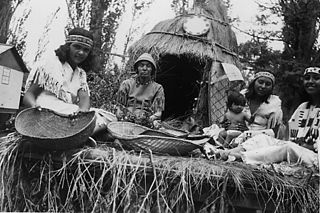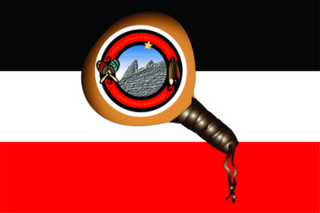
The Fort Mohave Indian Reservation is an Indian reservation along the Colorado River, currently encompassing 23,669 acres (95.79 km2) in Arizona, 12,633 acres (51.12 km2) in California, and 5,582 acres (22.59 km2) in Nevada. The reservation is home to approximately 1,100 members of the federally recognized Fort Mojave Indian Tribe of Arizona, California, and Nevada, a federally recognized tribe of Mohave people.

The Redding Rancheria is a federally recognized tribe with a reservation in Shasta County, Northern California. The 31-acre site (13 ha) of the Redding Rancheria was purchased in 1922 by the Bureau of Indian Affairs in order to provide Indigenous peoples with a place to camp and live. They had been made landless by European-American settlers in the area. Three groups of Native Americans in the area organized as a tribe and were recognized in 1979.
The Berry Creek Rancheria of Maidu Indians of California are a Native American people based in northeastern California, south of Lassen Peak. They historical have spoken the Konkow language, also known as Northeastern Maidu.

The Big Bend Rancheria is a settlement of the Pit River Tribe (Achomawi) north of Big Bend, in Shasta County, California. It is about 50 miles (80 km) northeast of Redding.
The Big Lagoon Rancheria is a federally recognized tribe of Yurok and Tolowa Indians. They are located in Humboldt County, California, and their tribal headquarters is in Arcata, California.

The Big Valley Band of Pomo Indians of the Big Valley Rancheria is a federally recognized tribe of Pomo and Pit River Indians, with a reservation located in Lake County, California, near the town of Finley. They conduct tribal business from Lakeport, California.

Havasu Lake is an unincorporated community in San Bernardino County, California, United States, located on Lake Havasu on the Chemehuevi Reservation in the Mojave Desert. The community serves as the seat of the tribal government of the Chemehuevi Indian Tribe and is home to the Havasu Landing Casino.

The Tule River Indian Tribe of the Tule River Reservation is a federally recognized tribe of Native Americans. The Tule River Reservation is located in Tulare County, California. The reservation was made up of Yokuts, about 200 Yowlumne, Wukchumnis, and Western Mono and Tübatulabal. Tribal enrollment today is approximately 1,857 with 1,033 living on the Reservation.

The Robinson Rancheria of Pomo Indians of California is a federally recognized tribe of Eastern Pomo people in Lake County, California.

The Fort Bidwell Indian Community of the Fort Bidwell Reservation of California is a federally recognized tribe of Northern Paiute Indians in Modoc County in the northeast corner of California.

The Bishop Paiute Tribe, formerly known as the Paiute-Shoshone Indians of the Bishop Community of the Bishop Colony is a federally recognized tribe of Mono and Timbisha Indians of the Owens Valley, in Inyo County of eastern California. As of 2022, the United States census showed the Bishop Paiute Tribe's population at 1,914.

The Pauma Band of Luiseño Mission Indians of the Pauma and Yuima Reservation is a federally recognized tribe of Luiseño Indians in San Diego County, California. A total of five other federally recognized tribes of Luiseño are located in southern California.

The La Posta Band of Diegueño Mission Indians of the La Posta Reservation is a federally recognized tribe of the Kumeyaay Indians, who are sometimes known as Mission Indians.

The Ewiiaapaayp Band of Kumeyaay Indians, formerly known as the Cuyapaipe Community of Diegueño Mission Indians of the Cuyapaipe Reservation, is a federally recognized tribe of Kumeyaay Indians, who are sometimes known as Mission Indians, located in San Diego County, California. "Ewiiaapaayp" is Kumeyaay for "leaning rock," a prominent feature on the reservation.

The Mountain Empire is a rural area in southeastern San Diego County, California. The Mountain Empire subregion consists of the backcountry communities in southeastern San Diego County. The area is also sometimes considered part of the East County region of San Diego County.

The Santa Ynez Band of Chumash Mission Indians is a federally recognized tribe of Chumash, an indigenous people of California, in Santa Barbara. Their name for themselves is Samala. The locality of Santa Ynez is referred to as ’alaxulapu in Chumashan language.
The Cher-Ae Heights Indian Community of the Trinidad Rancheria is a federally recognized tribe with members who are descendants of Chetco, Hupa, Karuk, Tolowa, Wiyot, and Yurok people in Humboldt County, California. As of the 2010 Census the population was 132.

The Mooretown Rancheria of Maidu Indians of California is a federally recognized tribe of Concow and Maidu people in Butte County. Concow, or Konkow, people are the northwestern or foothill branch of the Maidu people, who traditionally spoke the Concow language

The Montgomery Creek Rancheria is a federal Indian reservation belonging to members of the Pit River Tribe, a federally recognized tribe of indigenous people of California. The ranchería is located in Shasta County in northern California.

The Roaring Creek Rancheria is a federal Indian reservation belonging to Achumawi and Atsugewi members of the Pit River Tribe, a federally recognized tribe of indigenous people of California. The ranchería is located in Shasta County in north-central California.


















